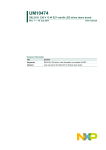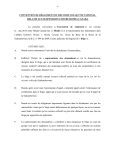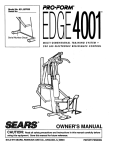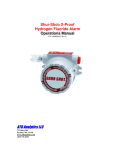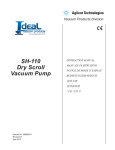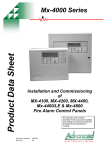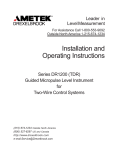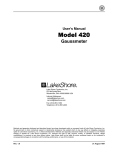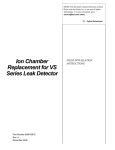Download AVE VCR 322 PLUS Instruction manual
Transcript
vacuum technologies Capacitance Diaphragm Gauge CDG-500 Instruction Manual Incl. EC Declaration of Conformity tqna49e1 (2010-05) 1 Product Identification In all communications with VARIAN, please specify the information given on the product nameplate. For convenient reference copy that information into the space provided below. VARIAN Lexington MA 02421 USA Model: PN: SN: V W Made in Liechtenstein 2 tqna49e1 (2010-05) Validity This document applies to products with the following part numbers: Gauges without switching functions Measurement range, Full Scale (F.S.) Part number Flange CDG500T1000KF16 DN 16 ISO-KF CDG500T1000VCR8 8 VCR CDG500T0100KF16 DN 16 ISO-KF CDG500T0100VCR8 8 VCR CDG500T0010KF16 DN 16 ISO-KF CDG500T0010VCR8 8 VCR CDG500T0001KF16 DN 16 ISO-KF CDG500T0001VCR8 8 VCR tqna49e1 (2010-05) ® ® ® ® Torr -1 Pascal 1 mbar 10 … 1000 (F.S.) 1.33×10 … 133'322 (F.S.) 1.33×10-1 … 1333 (F.S.) 10-2 … 100 (F.S.) 1.33×100 … 13'332.2 (F.S.) 1.33×10-2 … 133 (F.S.) 10-3 … 10 (F.S.) 1.33×10-1 … 1'333.22 (F.S.) 1.33×10-3 … 13.3 (F.S.) 10-4 … 1 (F.S.) 1.33×10-2 … 133.322 (F.S.) 1.33×10-4 … 1.3 (F.S.) 3 Gauges with two switching functions Measurement range, Full Scale (F.S.) Part number Flange CDG500T1000KF16S DN 16 ISO-KF CDG500T1000VCR8S 8 VCR CDG500T0100KF16S DN 16 ISO-KF CDG500T0100VCR8S 8 VCR CDG500T0010KF16S DN 16 ISO-KF CDG500T0010VCR8S ® 8 VCR CDG500T0001KF16S DN 16 ISO-KF CDG500T0001VCR8S ® ® ® 8 VCR Torr Pascal mbar 10-1 … 1000 (F.S.) 1.33×101 … 133'322 (F.S.) 1.33×10-1 … 1333 (F.S.) 10-2 … 100 (F.S.) 1.33×100 … 13'332.2 (F.S.) 1.33×10-2 … 133 (F.S.) 10-3 … 10 (F.S.) 1.33×10-1 … 1'333.22 (F.S.) 1.33×10-3 … 13.3 (F.S.) 10-4 … 1 (F.S.) 1.33×10-2 … 133.322 (F.S.) 1.33×10-4 … 1.3 (F.S.) The part number (PN) can be taken from the product nameplate. If not indicated otherwise in the legends, the illustrations in this document correspond to CDG-500 gauges with the DN 16 ISO-KF vacuum connection. They apply to the gauges with other vacuum connection by analogy. We reserve the right to make technical changes without prior notice. All dimensions in mm. 4 tqna49e1 (2010-05) Intended Use The Capacitance Diaphragm Gauge CDG-500 is intended for absolute pressure measurement of gases in its respective pressure range (→ 3). The gauge can be operated in connection with a VARIAN AGC-100 Vacuum Gauge Controller, a Varian Turbo AG Rack Controller, or with another appropriate measuring unit. Function The Capacitance Diaphragm Gauge consists of a capacitive sensor element made of aluminum oxide ceramics and electronics which convert the capacitance into a DC voltage output signal. The output signal is linear to the measured pressure and independent of the gas type. Trademark VCR® Swagelok Marketing Co. Patents EP 1070239 B1, 1040333 B1 US Patents 6528008, 6591687, 7107855, 7140085 Scope of Delivery 1× gauge 1× pin for adjusting settings via buttons 1× Calibration Test Report 1× Operating Manual tqna49e1 (2010-05) 5 Contents Product Identification Validity Intended Use, Function Trademark, Patents Scope of Delivery 2 3 5 5 5 1 Safety 1.1 Symbols Used 1.2 Personnel Qualifications 1.3 General Safety Instructions 1.4 Liability and Warranty 7 7 7 8 8 2 Technical Data 9 3 Installation 3.1 Vacuum Connection 3.2 Power Connection 14 14 17 4 Operation 4.1 Displays 4.2 Zeroing the Gauge 4.3 Switching Functions 4.4 Activating the Factory Setting (Factory Reset) 19 19 20 24 27 5 Deinstallation 28 6 Maintenance, Repair 30 7 Returning the Product 30 8 Disposal 31 Further Information 32 ETL Certification 33 EC Declaration of Conformity 34 For cross-references within this document, the symbol (→ XY) is used, for cross-references to further documents, listed under "Further Information", the symbol (→ [Z]). 6 tqna49e1 (2010-05) 1 Safety 1.1 Symbols Used DANGER Information on preventing any kind of physical injury. WARNING Information on preventing extensive equipment and environmental damage. Caution Information on correct handling or use. Disregard can lead to malfunctions or minor equipment damage. Notice 1.2 Personnel Qualifications Skilled personnel All work described in this document may only be carried out by persons who have suitable technical training and the necessary experience or who have been instructed by the end-user of the product. tqna49e1 (2010-05) 7 1.3 General Safety Instructions • Adhere to the applicable regulations and take the necessary precautions for the process media used. Consider possible reactions with the product materials. • Adhere to the applicable regulations and take the necessary precautions for all work you are going to do and consider the safety instructions in this document. • Before beginning to work, find out whether any vacuum components are contaminated. Adhere to the relevant regulations and take the necessary precautions when handling contaminated parts. Communicate the safety instructions to all other users. 1.4 Liability and Warranty VARIAN assumes no liability and the warranty becomes null and void if the end-user or third parties • disregard the information in this document • use the product in a non-conforming manner • make any kind of interventions (modifications, alterations etc.) on the product • use the product with accessories not listed in the product documentation. The end-user assumes the responsibility in conjunction with the process media used. Gauge failures due to contamination are not covered by the warranty. 8 tqna49e1 (2010-05) 2 Technical Data Measurement range Accuracy 1) Temperature effect on zero ≥10 Torr/mbar (F.S.) 1 Torr/mbar (F.S.) Temperature effect on span Resolution Gas type dependence Output signal analog (measuring signal) Voltage range Measuring range Relationship voltage-pressure Output impedance Loaded impedance Response time Gauge identification 1) tqna49e1 → "Validity" 0.20% of reading 0.0050% F.S./ °C 0.015% F.S./ °C 0.01% of reading / °C 0.003% F.S. none –5 … +10.24 V 0 … +10 V linear 0 Ω (short-circuit proof) >10 kΩ 30 ms Resistance 13.2 kΩ referenced to supply common (voltage at pin 10 ≤5 V) Non-linearity, hysteresis, repeatability in the calibrated range at 25 °C ambient operating temperature without temperature effects after operation of 2 h. (2010-05) 9 Switching functions Setting range SP1, SP2 0 … +10 V 1% F.S. Hysteresis Relay contact 30 VDC / ≤0.5 ADC floating (n.o.) at low pressure (LED is lit) at high pressure (LED is dark) closed open Switching time ≤50 ms RS232C interface Transmission rate Data format 9600 baud binary 8 data bits one stop bit no parity bit no handshake → "Electrical Connection" Connection Further information about the RS232C interface → [2]. Supply DANGER The gauge may only be connected to power supplies, instruments or control devices that conform to the requirements of a grounded protective extralow voltage (SELV) and limited power source (LPS), Class 2. The connection to the gauge has to be fused 2). Supply voltage at the gauge ripple 2) 10 +14 … +30 VDC Class 2 / LPS ≤1 Vpp VARIAN controllers fulfill this requirement. tqna49e1 (2010-05) Current consumption <500 mA (max. starting current) Power consumption (depending on supply voltage) Fuse required 2) ≤1 W 1 AT (slow), automatic reset (Polyfuse) The gauge is protected against reverse polarity of the supply voltage. Electrical connection Sensor cable without switching functions with switching functions Cable length 15-pin D-Sub, male 5-pin plus shielding 9-pin plus shielding ≤100 m (0.14 mm² conductor) For longer cables, larger conductor cross-sections are required (Rcable ≤1.0 Ω). Grounding concept Vacuum flange - signal common → "Power Connection" Supply common - signal common conducted separately; for differential measurement (10 Ω) Materials exposed to vacuum Flange, tube Sensor and diaphragm Sensor–diaphragm connection Ceramics–metal connection tqna49e1 stainless steel AISI 316L ceramics (Al2O3 ≥99.5%) glass ceramics solder AgTiCu hard solder, Vacon 70 (28% Ni, 23% Co, 49% Fe) Internal volume ≤3.6 cm3 Admissible pressure (absolute) 1000 Torr/mbar (F.S.) 1 … 100 Torr/mbar (F.S.) Bursting pressure (absolute) 3 bar 2 bar 5 bar (2010-05) 11 Admissible temperatures Storage Operation Bakeout (not in operation) Relative humidity Use Degree of protection –40 °C … +65 °C +5 °C … +50 °C ≤110 °C at the flange ≤80% at temperatures ≤+31 °C decreasing to 50% at +40°C indoors only, altitude up to 2000 m NN IP 30 Dimensions [mm] 44 44 69 3.8 ø55 DN 16 ISO-KF 8 VCR female Weight 12 ≤370 g tqna49e1 (2010-05) Analog Measuring Signal vs. Pressure Pressure p 1.1×F.S. 1.0×F.S. 0.9×F.S. 0.8×F.S. 0.7×F.S. 0.6×F.S. 0.5×F.S. 0.4×F.S. 0.3×F.S. 0.2×F.S. 0.1×F.S. 0.0×F.S. 0 1 2 3 4 5 6 7 8 9 10 Measuring signal Uout [V] p = (Uout / 10 V) × p (F.S.) Conversion Torr ↔ Pascal c Torr mbar 3) Pa 3) 1.00 1013.25 / 760 = 1.3332… 101325 / 760 = 133.3224… Example: Gauge with 10 Torr F.S. Measuring signal Uout = 6 V p = (6 V / 10 V) × 10 Torr = 0.6 × 10 Torr = 6 Torr 3) tqna49e1 Source: NPL (National Physical Laboratory) Guide to the Measurement of Pressure and Vacuum, ISBN 0904457x / 1998 (2010-05) 13 3 Installation WARNING WARNING: fragile components The ceramic sensor may be damaged by impacts. Do not drop the product and prevent shocks and impacts. 3.1 Vacuum Connection DANGER DANGER: overpressure in the vacuum system >1 bar Injury caused by released parts and harm caused by escaping process gases can result if clamps are opened while the vacuum system is pressurized. Do not open any clamps while the vacuum system is pressurized. Use the type clamps which are suited to overpressure. DANGER DANGER: overpressure in the vacuum system >2.5 bar KF flange connections with elastomer seals (e.g. O-rings) cannot withstand such pressures. Process media can thus leak and possibly damage your health. Use O-rings provided with an outer centering ring. 14 tqna49e1 (2010-05) DANGER DANGER: protective ground Products that are not correctly connected to ground can be extremely hazardous in the event of a fault. Electrically connect the gauge to the grounded vacuum chamber. This connection must conform to the requirements of a protective connection according to EN 61010: • VCR flanges fulfill this requirement. • For gauges with a KF flange, use a conductive metallic clamping ring. Caution Caution: vacuum component Dirt and damages impair the function of the vacuum component. When handling vacuum components, take appropriate measures to ensure cleanliness and prevent damages. Caution Caution: dirt sensitive area Touching the product or parts thereof with bare hands increases the desorption rate. Always wear clean, lint-free gloves and use clean tools when working in this area. tqna49e1 (2010-05) 15 Mount the gauge so that no vibrations occur. The gauge may be mounted in any orientation. To keep condensates and particles from getting into the measuring chamber preferably choose a horizontal to upright position and possibly use a seal with a centering ring and filter. If adjustment should be possible after the gauge has been installed, be sure to install it so that the buttons can be accessed with a pin (→ 20). Remove the protective lid and connect the product to the vacuum system. Seal with centering ring Clamp or Protective lid Seal with centering ring and filter Keep the protective lid. 16 tqna49e1 (2010-05) 3.2 Power Connection Make sure the vacuum connection is properly made (→ 14). DANGER The gauge may only be connected to power supplies, instruments or control devices that conform to the requirements of a grounded protective extralow voltage (SELV) and limited power source (LPS), Class 2. The connection to the gauge has to be fused 4). Ground loops, differences of potential, or EMC problems may affect the measurement signal. For optimum signal quality, please do observe the following notes: • Connect the cable shield to ground on one side via the chassis ground. Do not connect the other side of the shield. • Connect the supply common with protective ground directly at the power supply. • Use differential measurement input (signal common and supply common conducted separately). • Potential difference between supply common and housing ≤18 V (overvoltage protection). 4) tqna49e1 VARIAN controllers fulfill this requirement. (2010-05) 17 n If no sensor cable is available, make one according to the following diagram. Gauge with switching functions Ident TxD RxD 1 MΩ 100nF 18 V 10 Ω 4 1 8 9 10 13 14 2 12 7 11 5 15 case Electrical connection Pin 1, 4 Relay SP1, closing contact Pin 2 Signal Output or thresholds SP1/2 Pin 5 Supply common, GND Pin 7, 11 Supply Pin 8, 9 Relay SP2, closing contact Pin 10 Gauge identification Pin 12 Signal common Pin 13 RS232, TxD Pin 14 RS232, RxD Pin 15 Housing (Chassis Ground) case Connector case o p 18 9 1 15 8 D-Sub,15-pin female soldering side Connect the sensor cable to the gauge and secure it using the lock screws. Connect the sensor cable to the controller. tqna49e1 (2010-05) 4 Operation Put the gauge into operation. If you are using an VARIAN controller, define the measurement range (→ [1]). A warm-up time of at least ¼ hour should be allowed; for exact pressure measurements a warm-up time of at least 2 hours is required. 4.1 Displays RUN 1 ZERO 2 LED State Meaning <RUN> lit Measurement mode flashing Other mode, error, out of measurement range <1> *) lit p ≤ setpoint level 1 Adjusting setpoint <1> <2> *) flashing lit flashing *) tqna49e1 SP p ≤ setpoint level 2 Adjusting setpoint <2> Gauges with switching functions only. (2010-05) 19 4.2 Zeroing the Gauge The gauge is factory calibrated while "standing upright" (→ "Calibration Test Report"). We recommend performing a zero adjustment, when the gauge is operated for the first time. Due to long time operation or contamination, a zero drift could occur and zero adjustment may become necessary. For adjusting the zero, operate the gauge under the same constant ambient conditions and in the same mounting orientation as normally. The output signal (measuring signal) is depending on the mounting orientation. The signal difference between the vertical and horizontal mounting orientation is: F.S. 1000 Torr/mbar 100 Torr/mbar 10 Torr/mbar 1 Torr/mbar ΔU / 90° ≈2 mV ≈10 mV ≈50 mV ≈300 mV If the gauge is operated via a controller, the zero of the whole measuring system has to be adjusted on the controller: first, adjust the zero of the gauge and then, the zero of the controller. 20 tqna49e1 (2010-05) 4.2.1 <ZERO> Adjustment n Evacuate the gauge to a pressure according to the table below: F.S. 1000 100 10 1 Torr/mbar Torr/mbar Torr/mbar Torr/mbar Recommended final pressure for zero adjustment <5×10-2 Torr <5×10-3 Torr <5×10-4 Torr <5×10-5 Torr <6.65×100 Pa <6.65×10-1 Pa <6.65×10-2 Pa <6.65×10-3 Pa <5×10-2 mbar <5×10-3 mbar <5×10-4 mbar <5×10-5 mbar If the final pressure in the gauge is too high for zero adjustment (>25% of the F.S.), the zero cannot be reached and the <RUN> LED flashes. If this is the case, activate the factory setting and adjust the zero again (→ 27). o p Operate the gauge for at least ¼ hour (until the signal is stable). Briefly press the <ZERO> button with a pin (max. ø1.1 mm). The zero adjustment runs automatically. The <STATUS> LED flashes until the adjustment (duration ≤8 s) is completed. Press the button briefly max. ø1.1 mm tqna49e1 (2010-05) 21 After zero adjustment the gauge automatically returns to measurement mode. The <RUN> LED lits. The zero can also be adjusted via the RS232C interface (→ [2]). The <RUN> LED flashes if • the signal output is negative (< -20 mV) when the final pressure has been attained • the zero adjustment has failed. 4.2.2 <ZERO> Adjustment with Ramp Function The ramp function allows to adjust the zero at a known reference pressure within the measurement range of the gauge. It also permits to adjust an offset of the characteristic curve in order to • compensate for the offset of the measuring system or • obtain a slightly positive zero for a 0 … 10 V AD converter. The offset should not exceed 2% of the F.S. (+200 mV). At a higher positive offset, the upper limit of the measurement range is exceeded. Recommended procedure for adjusting the offset of a measuring system: → Notice 20. n o 22 Operate the gauge for at least ¼ hour (until the signal is stable). Push the <ZERO> button with a pin (max. ø1.1 mm) and keep it depressed. The <RUN> LED starts flashing. After 5 s, the zero adjustment value, starting at the current output value, keeps continually changing (ramp) until the button is released or until the setting limit (max. 25% F.S.) is reached. The corresponding output signal is delayed by about 1 s. tqna49e1 (2010-05) Keep the button depressed max. ø1.1 mm p Push the <ZERO> button again: Fine adjustment within 0...3 s: Change of direction within 3...5 s: the zero adjustment value changes by one unit (push <ZERO> button in intervals of 1 s) the zero adjustment changes its direction (the flashing frequency of the <RUN> LED changes briefly) If the <ZERO> button is released for more than 5 s, the gauge returns to the measurement mode. The zero with Base-Pressure-Offset can also be adjusted via the RS232C interface (→ [2]). The <RUN> LED flashes if the signal output is negative. tqna49e1 (2010-05) 23 4.3 Switching Functions The two switching functions can be adjusted to any pressure within the whole measurement range (→ 13). The current setpoint setting • is output at the D-Sub connector instead of the measurement signal (→ 18) and can be measured with a voltmeter after the <SP> button is pressed, or • can be read/written via the RS232C interface. If the pressure is lower than the setpoint, the corresponding LED is lit (<1> or <2>) and the corresponding relay (→ 18) is energized. Measurement signal (Pressure p) r em asu Me Setpoint e n t va lue Hysteresis (1% F.S.) Threshold value Off 24 On Off Time t tqna49e1 (2010-05) 4.3.1 Adjusting the Setpoints The setpoints can be adjusted via • the buttons on the gauge, • the RS232C interface (→ [2]). DANGER DANGER: malfunction If processes are controlled via the signal output, keep in mind that by pushing the <SP> button the measurement signal is suppressed and the corresponding threshold value is output instead. This can cause malfunctions. Push the <SP> button only if you are sure that no damages can arise from a malfunction. tqna49e1 (2010-05) 25 Adjusting Setpoint <1> n Push the <SP> button with a pin (max. ø1.1 mm). The gauge changes to the switching function mode and outputs the current lower threshold value at the measurement value output for about 10 s (LED <1> flashes). Press the button max. ø1.1 mm o For changing the threshold value, push the <ZERO> button and keep it depressed. The threshold keeps changing from the current value (ramp) until the button is released or until the limit of the setting range is reached. Keep the button depressed max. ø1.1 mm 26 tqna49e1 (2010-05) p Push the <ZERO> button again: Fine adjustment within 0...3 s: Change of direction within 3...5 s: the zero adjustment value changes by one unit the zero adjustment changes its direction (the flashing frequency of the <RUN> LED changes briefly) If the <ZERO> button is released for more than 5 s, the gauge returns the measurement mode. The upper threshold is automatically set 1% F.S. above the lower one (hysteresis). Adjusting Setpoint <2> Push the <SP> button twice (LED <2> flashes). The adjustment procedure is the same as for setpoint <1>. The setpoints can also be adjusted via the RS232C interface. 4.4 Activating the Factory Setting (Factory Reset) All user defined parameters (e.g. zero, filter) are restored to their default values. Loading of the default parameters is irreversible. Loading the default parameters: n o tqna49e1 But the gauge out of operation. Keep the <ZERO> button depressed for at least 5 s while the gauge is being put into operation (Power ON). (2010-05) 27 5 Deinstallation WARNING WARNING: fragile components The ceramic sensor may be damaged by impacts. Do not drop the product and prevent shocks and impacts. DANGER DANGER: contaminated parts Contaminated parts can be detrimental to health and environment. Before beginning to work, find out whether any parts are contaminated. Adhere to the relevant regulations and take the necessary precautions when handling contaminated parts. Caution Caution: vacuum component Dirt and damages impair the function of the vacuum component. When handling vacuum components, take appropriate measures to ensure cleanliness and prevent damages. 28 tqna49e1 (2010-05) Caution Caution: dirt sensitive area Touching the product or parts thereof with bare hands increases the desorption rate. Always wear clean, lint-free gloves and use clean tools when working in this area. n o p q tqna49e1 Vent the vacuum system. Put the gauge out off operation. Unfasten the lock screws and disconnect the sensor cable. Remove the gauge from the vacuum system and install the protective lid. (2010-05) 29 6 Maintenance, Repair Under clean operating conditions, the product requires no maintenance. Gauge failures due to contamination are not covered by the warranty. We recommend checking the zero at regular intervals (→ 21). VARIAN assumes no liability and the warranty becomes null and void if any repair work is carried out by the end-user or third parties. 7 Returning the Product WARNING WARNING: forwarding contaminated products Contaminated products (e.g. radioactive, toxic, caustic or microbiological hazard) can be detrimental to health and environment. Products returned to VARIAN should preferably be free of harmful substances. Adhere to the forwarding regulations of all involved countries and forwarding companies and enclose a duly completed declaration of contamination. Products that are not clearly declared as "free of harmful substances" are decontaminated at the expense of the customer. Products not accompanied by a duly completed declaration of contamination are returned to the sender at his own expense. 30 tqna49e1 (2010-05) 8 Disposal DANGER DANGER: contaminated parts Contaminated parts can be detrimental to health and environment. Before beginning to work, find out whether any parts are contaminated. Adhere to the relevant regulations and take the necessary precautions when handling contaminated parts. WARNING N WARNING: substances detrimental to the environment Products or parts thereof (mechanical and electric components, operating fluids etc.) can be detrimental to the environment. Dispose of such substances in accordance with the relevant local regulations. Separating the components After disassembling the product, separate its components according to the following criteria: • Contaminated components Contaminated components (radioactive, toxic, caustic or biological hazard etc.) must be decontaminated in accordance with the relevant national regulations, separated according to their materials, and disposed of. • Other components Such components must be separated according to their materials and recycled. tqna49e1 (2010-05) 31 Further Information 32 [1] www.varianinc.com INSTRUCTION MANUAL AGC-100 Vacuum Gauge Controller tqnb01e1 Varian Vacuum Technologies, Lexington, MA, 02421 USA [2] www.varianinc.com COMMUNICATION PROTOCOL RS232C Interface tqra49e1 Varian Vacuum Technologies, Lexington, MA, 02421 USA tqna49e1 (2010-05) ETL Certification 3103457 tqna49e1 (2010-05) ETL LISTED The product CDG-500 complies with the requirements of the following Standards: UL 61010-1, Issued: 2004/07/12 Ed: 2 Rev: 2005/07/22 CAN/CSA C22.2#61010-1, Issued: 2004/07/12 33 EC Declaration of Conformity We, VARIAN, hereby declare that the equipment mentioned below complies with the provisions of the Directive relating to electromagnetic compatibility 2004/108/EC. Product Capacitance Diaphragm Gauge CDG-500 Standards Harmonized and international/national standards and specifications: • EN 61000-6-2:2005 (EMC: generic immunity standard) • EN 61000-6-3:2001 (EMC: generic emission standard) • EN 61010-1:2001 (Safety requirements for electrical equipment for measurement, control and laboratory use) • EN 61326:1997 + A1:1998 + A2:2001 +A3:2003 (EMC requirements for electrical equipment for measurement, control and laboratory use) Manufacturer / Signature Varian Vacuum Technologies, 121 Hartwell Avenue, Lexington, MA, 02421 USA 19 May 2010 John Ehmann General Manager 34 tqna49e1 (2010-05) Notes tqna49e1 (2010-05) 35 vacuum technologies 121 Hartwell Avenue Lexington, MA, 02421 USA Tel: (781) 861 7200 Fax: (781) 861 5437 [email protected] t qna49e1 www.varianinc.com




































